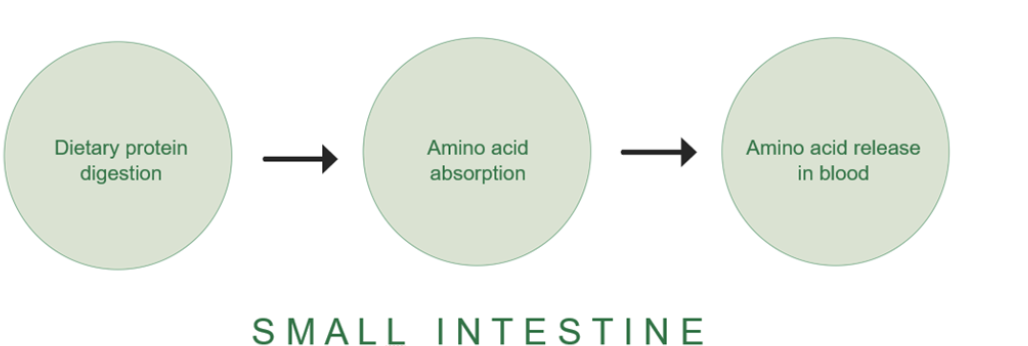The speed of protein digestion in chicks does matter!
Dietary protein digestion kinetics in chicks determines their lifetime performance
Article by Hamlet Protein
The inclusion of ileal digestible amino acids in the poultry ingredient matrices has been, without a doubt, a big step forward in the precision of feed formulation, allowing much more adjustment of least-cost optimization. However, evolution in the precision of feed formulation never stops, and today, it is increasingly important to consider protein digestion kinetics in poultry feed formulation. In this sense, the protein digestion kinetics or just “protein kinetics” is more indicative of feed efficiency and protein deposition and biological value than the extent of ileal digestible amino acids per se. In these times, with the high costs of feed ingredients we are facing, any move towards higher precision and subsequent cost optimization and performance improvement should be seriously considered. But what is protein kinetics?
Protein kinetics refers to the overall process of protein digestion in the lumen of the small intestine, absorption of amino acids by the intestinal epithelial cells and release of amino acids from the epithelium into the portal blood, which will later be used for the synthesis of tissues (muscles, organs, eggs). Protein kinetics also include the rate (speed) of the overall process, site of nutrient digestion along the small intestine and bioavailability of amino acids after eating. The entire process of protein kinetics occurs exclusively in the small intestine (Figure 1), along the proximal jejunum, distal jejunum, proximal ileum, and the distal ileum.
The faster the dietary protein digestion, the more it will occur in the proximal sections of the small intestine (jejunum) and the less will occur in the distal sections of the small intestine (ileum). In addition, the more protein digestion that happens in the proximal sections, the more amino acids will be absorbed and released into the bloodstream, because most of the amino acid absorption occurs in the jejunum, where glucose is more readily available as an energy source for the intestinal epithelial cells.

Thus, the post-enteral availability in the portal blood of most essential amino acids (isoleucine, leucine, methionine, phenylalanine, threonine, valine) and a few non-essential ones (asparagine, glycine proline) significantly and negatively correlates with feed conversion ratio (FCR) in chickens (Selle et al., 2016). In other words, the faster these amino acids are absorbed and transferred into the bloodstream, the lower the FCR. According to Selle et al. (2016), threonine has the most prominent relationship with FCR, as illustrated in Figure 2.

The intestinal section where digestion of a specific dietary protein source occurs depends on its proportion of rapidly digestible protein and its proportion of slowly digestible protein. The rapidly digested protein fraction will be absorbed in the jejunum and mostly deposited in the target tissues, while the slowly digested fraction will be absorbed in the ileum and mostly excreted via the urine. Thus, two protein sources or ingredients with the same ileal digestibility may show completely different digestion kinetics, one being much faster than the other. The fast protein fraction of each source will be digested in jejunum, whereas the slow protein fraction of each source will be digested in ileum, although their cumulative digestibility in the distal ileum is the same. Table 1 shows an example of two protein sources with the same ileal digestibility in chickens, but very different kinetic behavior, the digestion rate (speed) being much faster in one source than in the other.
The inclusion of rapidly digestible or slowly digestible protein sources in chicken feed will determine the protein kinetics of the whole diet. Berrocosso et al. (2020) compared feeding broilers on conventional soybean meal (SBM) diets with diets that, in addition to SBM, contained some slowly digestible protein sources (rapeseed meal, soy protein concentrate and corn gluten meal), all diets being formulated to meet requirements for ileal digestible amino acids. It was observed that broilers fed diets containing slowly digestible protein sources had a decreased average daily gain and increased FCR throughout the rearing period, but most notably after the starter phase.
Hamlet Protein recently conducted a trial with broilers at the facilities of Tests&Trials in Spain, in which 1,560 chicks were split in two groups, being fed a starter diet containing 29% SBM and 5% enzyme-treated soy protein (55.5% CP) or a starter diet containing 29 % SBM and 4.7% of SPC (60% CP). Both starter diets were isocaloric and presented the same profile of ileal digestible amino acids. The experimental diets were fed from 0 to 10 days of life and later, both groups of animals received the same grower (11-28 d) and finisher diets (29-42 d). The objective of this trial was to see the carry-over effect of two processed soybean products (enzyme-treated soy protein and SPC) added to the starter diet on the productive performance of the chickens throughout the entire productive cycle.

Parallel to the in vivo trial in Spain, the protein hydrolysis rate of the two processed soybean products included in the starter diets (enzyme-treated soy protein and SPC) was determined in vitro at Aarhus University (Denmark). Likewise, the protein hydrolysis rate was also determined in the pool of each of the two starter diets, the one supplemented with enzyme-treated soy protein and the one supplemented with SPC. The curves representing the degree of protein hydrolysis for 2 hours and the hydrolysis rate constant (k) for each product and feed sample are shown in Figures 3 and 4, respectively.
The rate of protein hydrolysis in enzyme-treated soy protein was 230% faster than that of SPC. Consequently, the inclusion of enzyme-treated soy protein in the starter diet resulted in a 30% higher rate of protein hydrolysis of the whole diet than the rate of protein hydrolysis of the SPC-supplemented diet. This shows that the type of manufacturing process of these concentrated protein sources significantly determines their behavior at the level of digestion kinetics. In other words, the enzymatically treated soy protein presents a much faster digestion speed than the SPC produced by hydro-alcoholic extraction.
The results of the in vivo trial in Spain demonstrated the superiority of enzyme-treated soy protein over SPC (Figure 5). Chickens fed the enzyme-treated soy protein diet in the starter period had significantly higher body weights than chickens fed the SPC-supplemented diet throughout the entire production cycle. Regarding FCR, chickens from the enzyme-treated soy protein group had numerically better feed efficiency than chickens from the SPC group at the end of the rearing period.


These two studies (in vitro in Denmark and in vivo in Spain) confirm that not all soy protein-based products have the same behavior in the intestine of birds. In addition, from the results of both studies it can be concluded that starter diets supplemented with a rapidly digestible protein source (e.g. enzyme-treated soy protein) result in a higher productive performance at the end of the productive cycle than that obtained by feeding chicks a starter diet supplemented with a slowly digestible protein (e.g. hydro-alcohol extraction SPC). If you want to delve more into the protein digestion kinetics in your starter feed and how it affects the performance of your birds and your profit, don't hesitate... get in touch with us!


